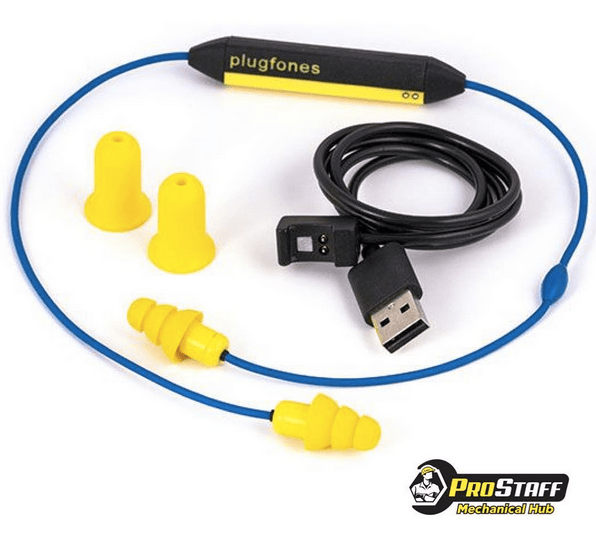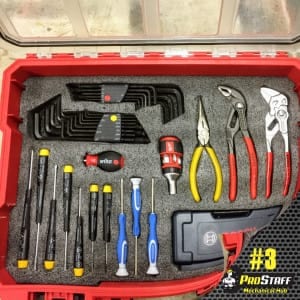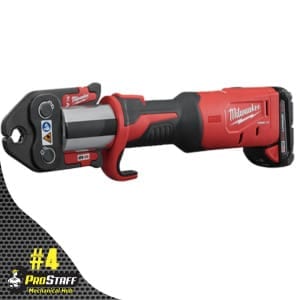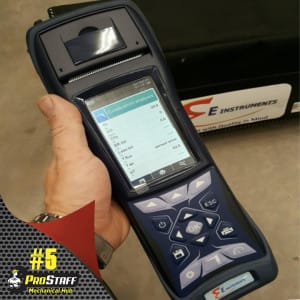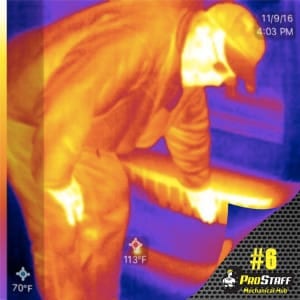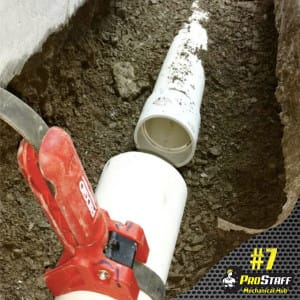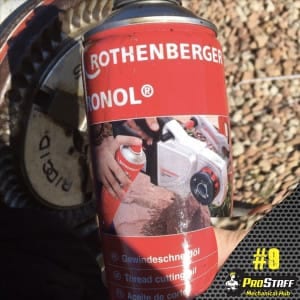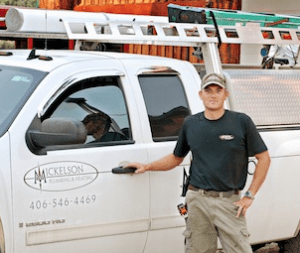Here’s a quick look at the Milwaukee Tool Cheater pipe wrench 48-22-7314. When I first got my hands on the Cheater wrench I was blown away by its simplicity. I thought “Why hadn’t someone thought of this decades ago?!” This wrench had the potential to replace my traditional, fixed-length wrenches but it’s not there just Read more
ShopTalk

Here’s a quick look at the Milwaukee Tool Cheater pipe wrench 48-22-7314.
When I first got my hands on the Cheater wrench I was blown away by its simplicity. I thought “Why hadn’t someone thought of this decades ago?!”
This wrench had the potential to replace my traditional, fixed-length wrenches but it’s not there just yet. Milwaukee is pushing the fact that this wrench takes the place of three wrenches but I’m not yet convinced. To me it’s either a short, medium length or too long of a wrench for 1/2″-1″ pipe sizes.
I’d prefer some modification to the handle to increase grip and control. With some improvement I’d be more inclined to use it up high or overhead. Check out a related Instagram post for more thoughts and comments by many of my followers.
If you look close you’ll see some chipped paint on the wrench head. I’m not sure if this is epoxy or powder coat but it’s chipped in about ten spots, rust will form there no doubt. I’ve had this wrench since June/July ’16. It’s been used weekly at least. I should have included this in the video: This wrench retails for $99. That’s a bit high in my opinion. I get why the pricing is set there, marketing it as a 3-n-1 but it doesn’t truly replace three wrenches and therefor I’d say the current price is upwards of $30 too high. Just my opinion. Please click the video below for a look.
https://www.youtube.com/watch?v=ijoqAGaZ2CY
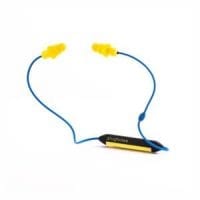
Bluetooth earplugs? When I first learned of the Plugfones NRR earplugs I had no idea they were built for playing music but rather thought they were a some sort of powered noise-cancelling protection device. I was pleased to find out I was wrong, because you know, music while I work. I’ve been using the Plugfones Read more
 Bluetooth earplugs? When I first learned of the Plugfones NRR earplugs I had no idea they were built for playing music but rather thought they were a some sort of powered noise-cancelling protection device. I was pleased to find out I was wrong, because you know, music while I work.
Bluetooth earplugs? When I first learned of the Plugfones NRR earplugs I had no idea they were built for playing music but rather thought they were a some sort of powered noise-cancelling protection device. I was pleased to find out I was wrong, because you know, music while I work.
I’ve been using the Plugfones “Liberate” model of Bluetooth earplugs with music for a little over a month.
If you’re not familiar these ear-buds offer a certified noise reduction rating (NNR) of 25db. As far as I know there are no other earplugs w/ music on the market with a NNR rating.
I’ve got the 18″ model, a 14.5″ model is available and it offers a mic for phone call use. The 18″ model does not. Battery life is rated for up to 8 hours. The integrated remote houses a 220mAh battery, stop/play, skip and volume control buttons.
Charging is done via a contact docking USB cord. Carry case and replacement foam earplugs are included as well. I use the silicone earplugs on mine, I find them more comfortable and convenient.
You can order these online thru multiple retailers or directly from Plugfones. Cost is $99 and justifiable if you’re in need of NNR hearing protection. I have no reason to believe these will not last me for a long time. Sound quality is on par with any other lower cost wireless ear-buds I have owned or used in the past.
Wired Plugfones are also available and cost significantly less. The average price I’ve seen the wired models at stores in my area has been $20.00. If you’re in need of certified volume-limited ear buds they’ve got you covered with their “Contractor VL ” model that keeps the volume level of the Plugfones speakers at or below 82 dB per OSHA standards. “VL” signifies volume-limiting and is only available in the wired models.
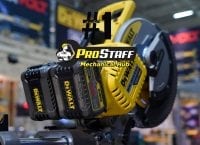
My pick for number one in the Top Tools of 2016 is the DEWALT Flexvolt system. Picking only one tool from the growing list of Flexvolt tools would be tough, I’m not even sure where I’d start but I suppose I’d have to first consider the first battery to hit the scene that actually changes Read more
My pick for number one in the Top Tools of 2016 is the DEWALT Flexvolt system. Picking only one tool from the growing list of Flexvolt tools would be tough, I’m not even sure where I’d start but I suppose I’d have to first consider the first battery to hit the scene that actually changes voltages depending on the tool it is connected to. I picked the whole system of Flexvolt tools because only choosing the battery pack would leave out the high performance tools Dewalt had engineered to do mass amounts of work on the voltage-changing platform. Picking one specific tool would then take the honor of being the number one tool away from the battery pack; an honor that really belongs to Dewalt and the whole Flexvolt system.
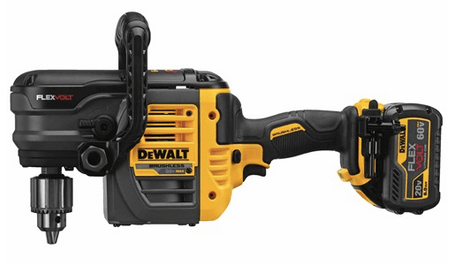 Cordless job sites are now a reality. We’ve been gearing up for this for the last 4-5 years but falling short in key areas, some trade specific. The plumber, hvac installer and electrician have had a cordless drilling option for stud and joists for almost two years from a major competitor. Dewalt’s new Flexvolt 60v MAX VSR Stud & Joist Drill is built for rough-in drilling of large diameter holes in wood. I’ve pitted the VSR up against the Super Hawg multiple times as have others with the results always stacking in Dewalt’s favor. The speed and constant power along with the battery’s ability to remain cooler allow this drill to perform longer and drill more holes than its nearest competitor.
Cordless job sites are now a reality. We’ve been gearing up for this for the last 4-5 years but falling short in key areas, some trade specific. The plumber, hvac installer and electrician have had a cordless drilling option for stud and joists for almost two years from a major competitor. Dewalt’s new Flexvolt 60v MAX VSR Stud & Joist Drill is built for rough-in drilling of large diameter holes in wood. I’ve pitted the VSR up against the Super Hawg multiple times as have others with the results always stacking in Dewalt’s favor. The speed and constant power along with the battery’s ability to remain cooler allow this drill to perform longer and drill more holes than its nearest competitor.
60V Max is about building more powerful and more capable tools. At higher voltages, less current draw is needed to achieve the same power output, and that means greater efficiency and lower losses. It is this exact engineering that keeps the Flexvolt tools running longer than their competitors and that means less downtime. Less downtime means more work is being done. 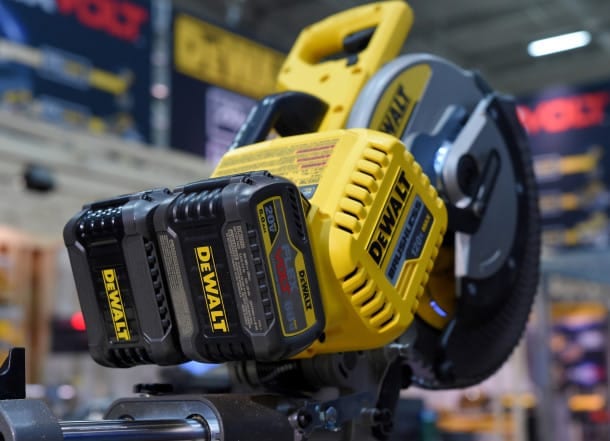 The Flexvolt system is more than a powerful drill and high capacity battery though. I’ve been working with the 12” 120V double bevel compound miter saw kit for months now in my shop. Because of the battery’s engineering this typically corded tool is able to operate as a cordless tool but with corded performance characteristics. Dozens and dozens of cuts can be made with either (2) Flexvolt packs or the 120V corded power adaptor.
The Flexvolt system is more than a powerful drill and high capacity battery though. I’ve been working with the 12” 120V double bevel compound miter saw kit for months now in my shop. Because of the battery’s engineering this typically corded tool is able to operate as a cordless tool but with corded performance characteristics. Dozens and dozens of cuts can be made with either (2) Flexvolt packs or the 120V corded power adaptor.
Flexvolt is also a 20V system for tools like typical drills and impact drivers. The voltage switch for 20V MAX tools allows for the new Flexvolt batteries to be backwards compatible with existing 20V MAX tools the whole platform of tools operating on the battery system. Each of the Flexvolt tools we’ve tested has been outstanding in all performance ratings. The ergonomics of these heavy-duty, high demand tools shows an improvement over previous 20V MAX tools as well. Durability and life span have not been confirmed yet because all of our tools are less than a year old now but I will continue to push them to the limit on the job and report back if anything out of the norm happens.
The Flexvolt battery automatically switches between two voltages, 20V & 60V. The ability to use a single battery in multi-volt applications improves worker efficiency and expands the types and amount of tools capable of moving from corded to cordless. For more information on how the batteries are built and operate see below.
SERIES MODE
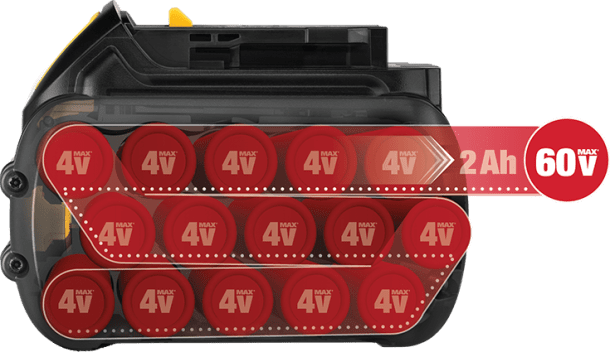 In parallel mode [20V MAX] the Flexvolt 15-cell battery can deliver up to 4X the runtime** to your current 20V MAX* tools. In this mode, three sets of five cells each are connected in parallel to give you 20V MAX* and 6 Ah for increased runtime. New 9 Ah packs are now available, increasing the runtime and tool performance even further.
In parallel mode [20V MAX] the Flexvolt 15-cell battery can deliver up to 4X the runtime** to your current 20V MAX* tools. In this mode, three sets of five cells each are connected in parallel to give you 20V MAX* and 6 Ah for increased runtime. New 9 Ah packs are now available, increasing the runtime and tool performance even further.
PARALLEL MODE
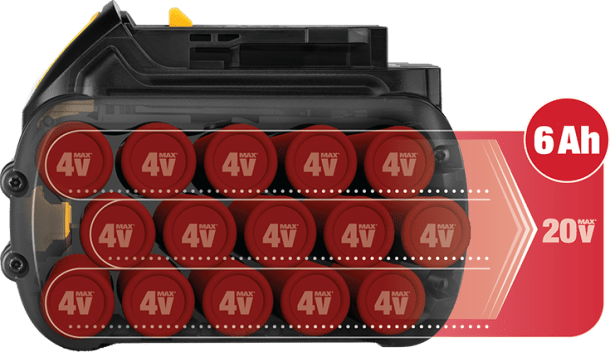 When you mate the Flexvolt battery into the new line of 60V MAX brushless tools, the battery automatically changes to SERIES MODE. In this mode, all fifteen cells are connected in series to provide 60V MAX for the power of corded. Around the shop we have started to call this BEAST MODE. The Flexvolt 6Ah packs are built with 18650 sized lithium cells. The 20V MAX and Flexvolt 9Ah packs are built with 20700 form factor cells. 20700 sized cells are larger and capable of delivering more power the 18650 sized cells of the same charge capacity.
When you mate the Flexvolt battery into the new line of 60V MAX brushless tools, the battery automatically changes to SERIES MODE. In this mode, all fifteen cells are connected in series to provide 60V MAX for the power of corded. Around the shop we have started to call this BEAST MODE. The Flexvolt 6Ah packs are built with 18650 sized lithium cells. The 20V MAX and Flexvolt 9Ah packs are built with 20700 form factor cells. 20700 sized cells are larger and capable of delivering more power the 18650 sized cells of the same charge capacity.
If impacts, drills or saws aren’t enough Dewalt has brought a industry first to the job site with the DCB1800 Powerstation. The power station is a portable generator running off (4) 20v MAX batteries, not a gas engine so indoor use is not a problem. The inverter is silent in comparison to any other portable power solution as well making it a non-factor where noise is a obstacle to getting the job done. This is a gamechanger for those looking to knock out some punch list items at the end of the job or quickly get in and out to complete a task with a corded tool when cordless isn’t available.
https://www.youtube.com/watch?v=bHT9eJi9cvM
Check out the complete list of Top Tools of 2016
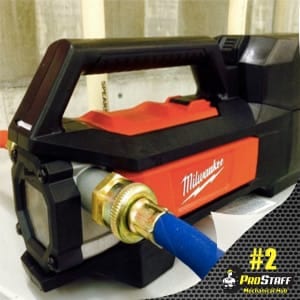
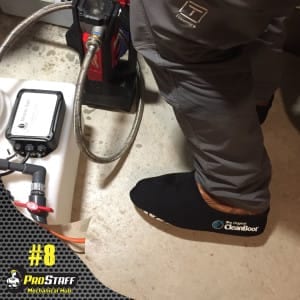

- Top Tools of 2016: #10
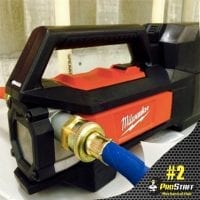
My number two pick for Top Tools of 2016 is the Milwaukee M18 Transfer Pump. This is a product that was long needed in the plumbing and HVAC space. Our ProStaff did a complete review on the pump. Initially we had an issue with the hose adapter fittings but our comments were taken Read more
 My number two pick for Top Tools of 2016 is the Milwaukee M18 Transfer Pump. This is a product that was long needed in the plumbing and HVAC space. Our ProStaff did a complete review on the pump. Initially we had an issue with the hose adapter fittings but our comments were taken straight to the Milwaukee engineering department and the issue has been fixed. That was the icing on the cake for me; Milwaukee took our feedback and worked out a solution. That’s awesome. Please see the full review below.
My number two pick for Top Tools of 2016 is the Milwaukee M18 Transfer Pump. This is a product that was long needed in the plumbing and HVAC space. Our ProStaff did a complete review on the pump. Initially we had an issue with the hose adapter fittings but our comments were taken straight to the Milwaukee engineering department and the issue has been fixed. That was the icing on the cake for me; Milwaukee took our feedback and worked out a solution. That’s awesome. Please see the full review below.
One of the biggest hits at this year’s Milwaukee Tool New Product Symposium—from the plumbing department—was the new, self-priming M18 Transfer Pump. The Hub shot a Facebook Live video from the event and received more than 8,000 views within the first couple of hours of seeing a demo for the first time.
Our ProStaffers were chomping at the bit to get their hands on one, so we sent it out to Bob ‘Hot Rod’ Rohr; Andy Mickelson, owner, Mickelson Plumbing & Heating; and the Hub’s Eric Aune, owner, Aune Plumbing LLC, for testing and review.
According to Rohr, the pump is well built and has nice fit and finish. “If weight—7.9 lbs.— equals quality, and the tool is properly used and maintained, this should be a coveted, long-lasting tool,” says Rohr. Aune and Mickelson agree, “The pump is lightweight compared to typical transfer pumps used on the job—cast iron usually,” says Aune.
“The weight is a big plus, as we are frequently packing our equipment though a house. This unit easily fits in a 5-gallon bucket with hoses for transportation,” says Mickelson.
The pump has a nice balance when carrying and using with one hand. Yet, says Aune, while the carry handle protects on/off switch, the handle makes it somewhat difficult to access the button. Rohr’s solution? If you hold the tool with your right hand, index finger towards the battery, “I found you can use the tip of your thumb to activate the switch. This frees up your left hand, and allows one-handed operation.”
The battery is protected under a hinged, tight fitting cover. Warranty is a generous—5 years. Performance on 5.0 battery, washer hoses, draining 50-gal H2O heater, for instance: 12 minutes—that’s fast, would be faster with larger hoses. Runtime on 9ah battery increases by almost 2x. “When paired with the 9.0 battery I see this being a very versatile tool, providing an exceptional run time for a cordless tool,” says Mickelson.
And, no additional cord to plug in is added value and makes jobs easier/faster.
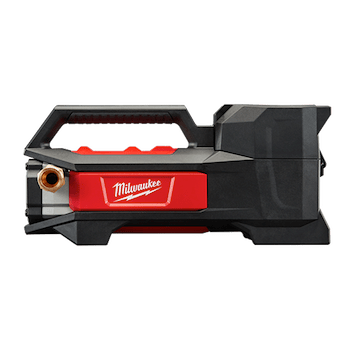
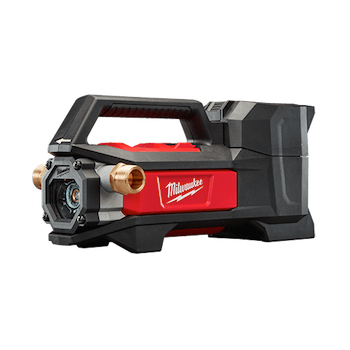
Rohr says that he did not see any pump curve information included in the box. The spec sheet indicates 18’ maximum lift and up to 75’ head, or about 35 psi. (144 gallons per battery charge, about 20 minutes.)
The pump does run much louder when it is pumped dry, indicating it is time to power it down. Milwaukee indicates not over 10 seconds of dry run. The pump should shut down after 1 minute of dry run, via the battery technology.
Rohr considers the pump a flexible impeller style of pump, a design around since 1800s. Some refer to this style as a positive displacement-style pump also. Mickelson continues that even with mild system back pressure the pump does not spin backwards when turned off, acting as check valve almost. And Aune says that the impeller is replaceable. If left to run dry, it will need replaced at some point.
What about glycol? The instructions mentions clear water use only—note the 140°F maximum fluid temperature—so check with Milwaukee regarding glycols or GEO fluids. It is rated only for water but Aune Plumbing has pumped straight undiluted glycol and rinsed pump without problem. Mickelson pumped thick cold glycol with the pump and had great results thus far. “Perhaps if the pump is flushed with clear water after use this will be acceptable. Milwaukee mentions flushing with clear water should ‘anything but clear water be accidently pumped.’ For plumbing and HVAC use it needs to be able to handle the typical, clean heat transfer fluid, in my opinion,” says Rohr.
Funky Fittings?
If you want full performance from this pump, I’d suggest a 5/8 or 3/4” hoses, says Rohr. I did need to use a pliers to get a new hose to seal tightly, the threads seem a bit tight, time may wear these in so hand tightening is all that is required. Aune did notice some issues with the connections. “The hose fittings are odd in that some of my hoses will not tighten properly without wrench and effort,” says Aune.

UPDATE:
Since the original posting of this review Milwaukee has taken our concerns about the hose fittings to the product engineering team for a solution. Effective immediately all new transfer pumps have been fitted with hose adapters that work with a wider variety of hose connections.
On the Job
Hot Rod perched it on top of a 6-foot ladder and pumped from an open 5-gallon bucket. The pump primed instantly, first time out of the box. My first test was with a common washing machine-type hose, about 3/8 actual hose inside diameter. The operation manual does suggest a ¾” ID hose.
It took just under two minutes to empty the bucket, with the restrictive, off-the-shelf wash machine hoses. Pumping straight out of the pump, no hose on the discharge.
He then switched to a hose with a full 5/8” ID and the bucket emptied in 37 seconds! So at 6-ft. lift, wide-open discharge I measured just under 8 gallons per minute flow rate.
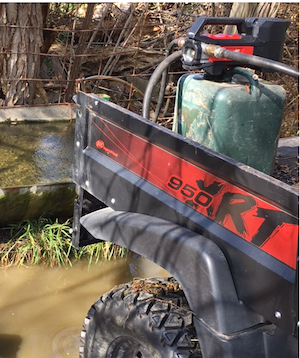 His first job was to re-prime a siphon hose that fills a stock watering tank. The inlet end hose plugs with debris from the pond source from time to time. Rohr pumped clean water from a 5-gallon bucket into the siphon line to get the system flowing gain. This is one of the many tasks Rohr sees this cordless pump being used for around the shop.
His first job was to re-prime a siphon hose that fills a stock watering tank. The inlet end hose plugs with debris from the pond source from time to time. Rohr pumped clean water from a 5-gallon bucket into the siphon line to get the system flowing gain. This is one of the many tasks Rohr sees this cordless pump being used for around the shop.
Mickelson has flushed two tankless water heaters with this pump and he loves the self-prime feature. “The rubber impeller seems to be holding up nicely with the acid solution we use to clean the heaters. It also has shown no ill effects of pumping glycol or acid solutions.”
The techs at Mickelson Plumbing and Heating were able to pressurize a heating system with 33% propylene glycol to roughly 22 PSI with the pump. During this process we had pumped 30 gallons of fluid into the heating system, and purged the air out of the system with the pump for an additional 25 minutes, and the 9.0 battery still had 2 bars left on it!
The verdict
• Rohr: This should be a homerun for Milwaukee Tool. With the versatile M-18 battery pack, this useful pump should find it way on many service trucks.
• Aune: Easily the handiest pump for cleaning/flushing tankless water heaters I’ve ever used. Slam-dunk design and performance for the money. It’s not inexpensive but fits perfectly within the M18 platform, which is very popular in the plumbing/HVAC trades
• Mickelson — This model, less the battery is less money than the current transfer pumps that we use. Will be buying more cordless versions very shortly.
Finally, for the HVAC contractor, Rohr suggests this as a transfer pump for filling or topping off hydronic, geothermal or solar systems. Plumbers may find it ideal for empting water heaters, assuming the drain cock is not plugged. If so add a PEX dip tube from the top of the tank to prevent pulling sediment from the bottom drain valve.
Retail price:
$179.00 for bare tool
$279.00 for kit
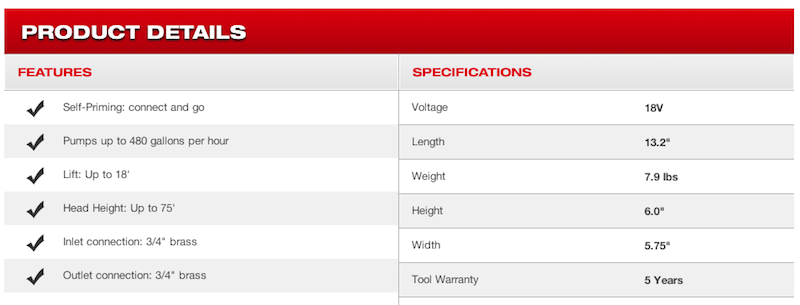
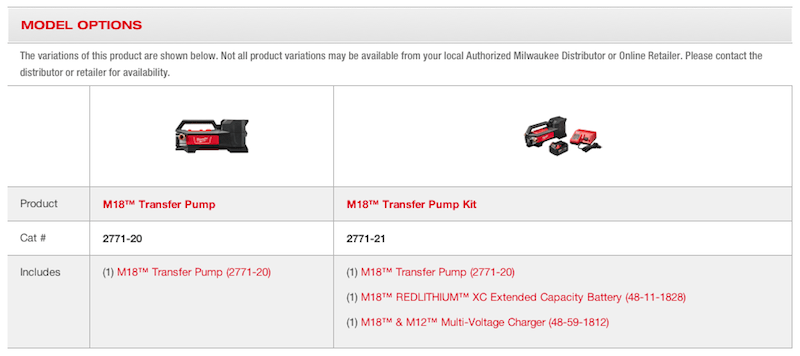
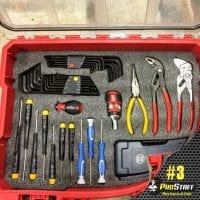
Organizing and protecting tools has always been a challenge. This last summer I found a new product that has not only changed my habits but has saved me time and money. Kaizen foam inserts are custom made, cnc machined faom inserts for popular tool boxes and organizer boxes like the Milwaukee Jobsite Organizer (pictured). The Read more
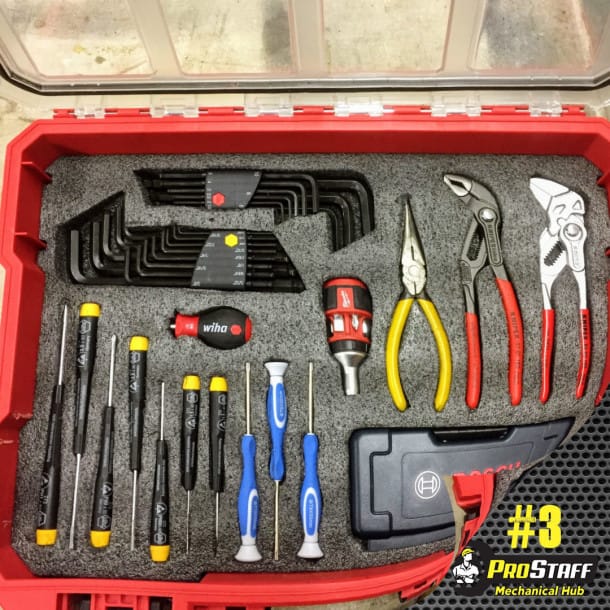 Organizing and protecting tools has always been a challenge. This last summer I found a new product that has not only changed my habits but has saved me time and money. Kaizen foam inserts are custom made, cnc machined faom inserts for popular tool boxes and organizer boxes like the Milwaukee Jobsite Organizer (pictured).
Organizing and protecting tools has always been a challenge. This last summer I found a new product that has not only changed my habits but has saved me time and money. Kaizen foam inserts are custom made, cnc machined faom inserts for popular tool boxes and organizer boxes like the Milwaukee Jobsite Organizer (pictured).
The foam is closed cell laminated layers cut specifically to the inside dimensions of specific boxes. You order the foam in select depths that can be combined or used alone to proved the base in which you layout and organize whatever you’d like to protect and place in your tool box.
The layout of your tools is completely up to you, you do the cutting and removal of the foam where it best fits your needs. So far I have organized five boxes; most of my boxes are filled with tools I use everyday but a couple are for tools that don’t have great storage options so having them protected and organized the way I want makes tracking and accessing those tools easier than ever with the foam inserts.
“Stop the struggle” is Kaizen’s motto and I truly believe it does exactly that. Here are some examples of the boxes I have created so far. I feel obligated to warn you though, this stuff is addicting. Once you start you’ll soon find all kinds of tools and items you’d like to organize!


